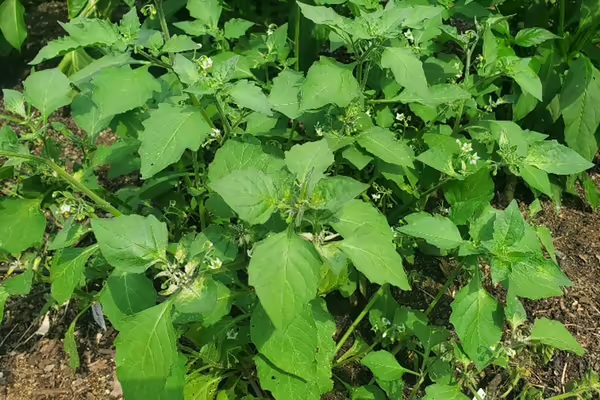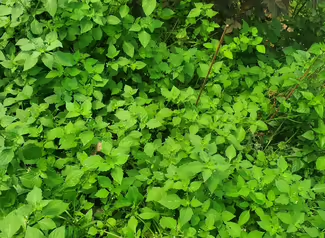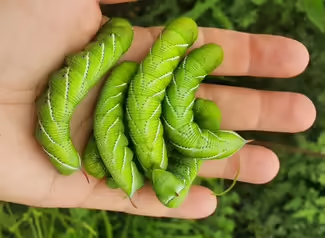
URBANA, Ill. — The quest for a new item to add to the garden this past winter led one horticulture educator, Christina Lueking, to grow a summertime berry that might fill a gap after the strawberry harvest fizzled, and before the raspberries matured. An interesting packet of seeds for a plant called wonderberry or sunberry (Solanum burbankii) caught their attention.
About Wonderberry
According to Encyclopedia Britannica, renowned American plant breeder Luther Burbank created this fruit in the early 1900s. The wonderberry plant belongs to the poisonous nightshade family (Solanaceae). Although that sounds frightening for beginner gardeners or families with small children, the nightshade genus also contains several economically important food crops like tomatoes, potatoes, and eggplant.
Growing Wonderberries
To start the quest, the wonderberry seeds were purchased and started in a small greenhouse until the threat of frost passed. The little seedlings were planted in two locations to test if these would be a good choice for the community garden setting next summer. The plants bushed out with an elevated growth habit with small white flowers. After flowering, the plant produced multiple clusters of small round berries.
One set of seedlings was planted outside in the garden, while a second set was planted in a raised bed in the high tunnel greenhouse. This is where disaster struck. Even an experienced gardener has a life where stuff just happens. A busy schedule and night meetings led to not checking on the plants for a few days.
According to Lueking, a little sideline statement brought her back to being a plant mom when her daughter said, “Hey, Mom, I took a little green worm off your plant. You might want to check it out.” Instantly, it was a fast-paced walk out to check on the wonderberries.
To her surprise, the wonderberry stems had munched-on, shredded leaves and covered with a healthy crop of tomato hornworms, including five spotted hawk moths (Manduca quinquemaculata). Yes, a healthy crop, as in 55 worms, had taken up residency in the berry patch. Lueking recounts knowing the exact number as she hand-pulled them from that plant to take them to a more suitable home outside of the high tunnel greenhouse and away from the wonderberries.
As gardeners, many know how plants can rebound, and all is not lost. As an Extension educator, her role is to advise, and therefore, the advice was to give plenty of water and increase pest monitoring to keep the plant healthy. The wonderberries are now branched out with several hundred white flowers and clusters of berries.
Harvesting Wonderberries
Initially green, the berries will grow larger and then turn from green to a shiny blackish-blue when ripe. A strong word of caution: do not pick green berries. They can be poisonous since every individual reacts differently when exposed to items. The green berries will also have a bitter taste that is unpleasant to individuals. Wonderberries picked ripe are soft, juicy, and highly seeded with an outer skin like a grape. The best way to harvest is to allow them to ripen on the plant to the blackish-blue color, gently roll the berries between fingers from the cluster, and fall into the palm or bowl. The ripe wonderberry has a soft, mild, slightly sweet, bland flavor. It is best to use as a jelly, jam, or pie filling.
Wonderberries are annual in growing zone 6 and will not tolerate a frost event. Lueking’s journey is still underway in the garden, and no decision has been made on whether this would be a good choice for a community garden setting. Regardless, wonderberries will be produced until fall, and a new growing experience was had by all.
For gardening and growing questions, connect with a location Extension office at go.illinois.edu/ExtensionOffice.
Christina Lueking is an Illinois Extension horticulture educator for Bond, Clinton, Jefferson, Marion, and Washington counties. Gardeners Corner is a quarterly newsletter from gardening experts around the state. Each issue highlights best practices that will make your houseplants, landscape, or garden shine in any season. Join the Gardener’s Corner email list at go.illinois.edu/GCsubscribe for direct access to timely tips.
References: Encyclopedia Britannica, T. Editors of Encyclopedia. "Luther Burbank." Encyclopedia Britannica Online, April 7, 2024. britannica.com/biography/Luther-Burbank.
PHOTO CAPTION: A healthy and growing wonderberry flowering in a garden. Photo: Christina Lueking, Illinois Extension.
University of Illinois Extension develops educational programs, extends knowledge, and builds partnerships to support people, communities, and their environments as part of the state's land-grant institution. Extension serves as the leading public outreach effort for University of Illinois Urbana-Champaign and the College of Agricultural, Consumer and Environmental Sciences in all 102 Illinois counties through a network of 27 multi-county units and over 700 staff statewide. Extension’s mission is responsive to eight strategic priorities — community, economy, environment, food and agriculture, health, partnerships, technology and discovery, and workforce excellence — that are served through six program areas — 4-H youth development, agriculture and agribusiness, community and economic development, family and consumer science, integrated health disparities, and natural resources, environment, and energy.


